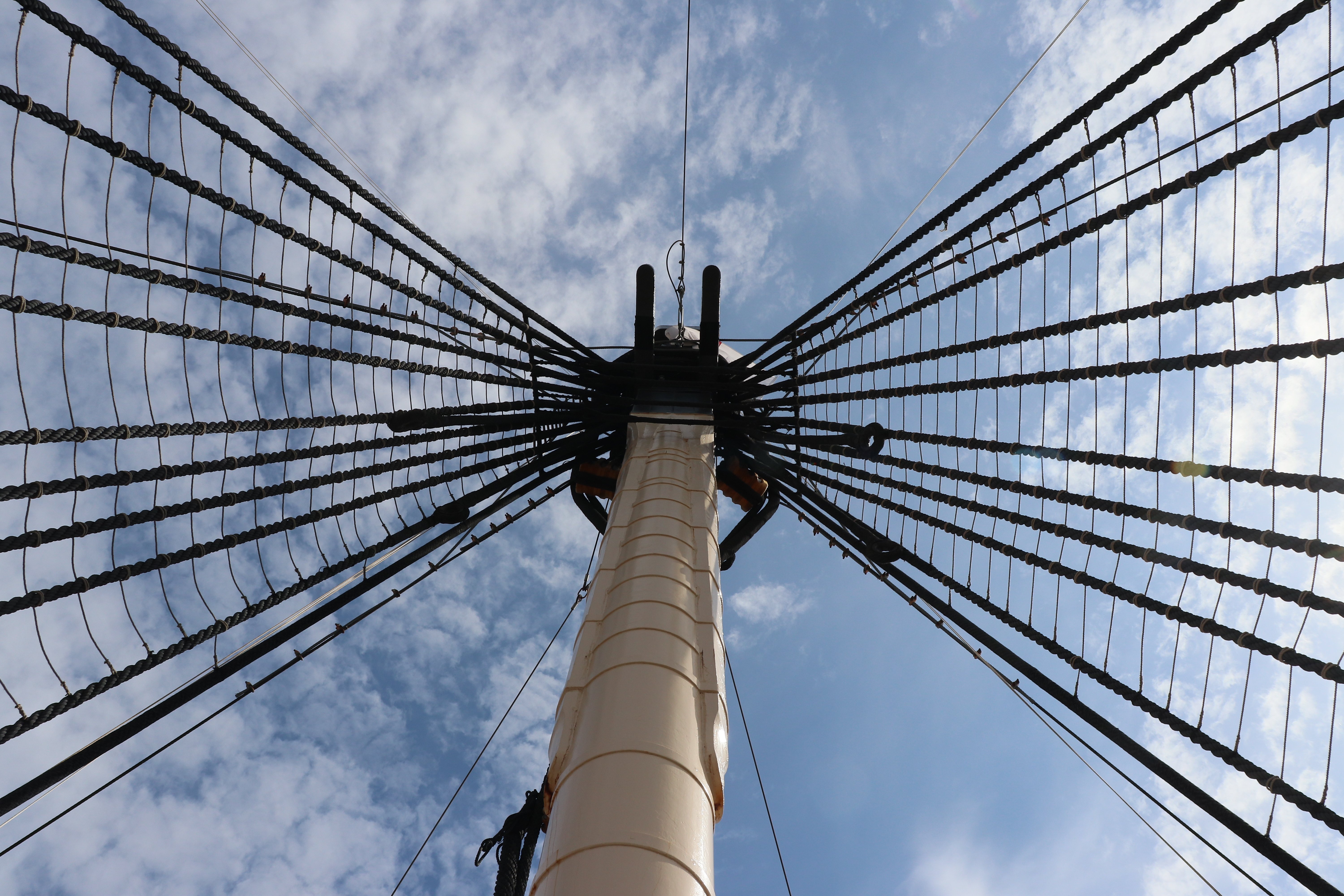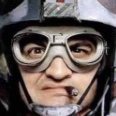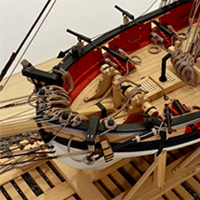-
Posts
416 -
Joined
-
Last visited
Reputation Activity
-
 Robert29 got a reaction from TrunkMonkey in HMS Victory 1805 by Robert29 - FINISHED - Caldercraft - Scale 1:72
Robert29 got a reaction from TrunkMonkey in HMS Victory 1805 by Robert29 - FINISHED - Caldercraft - Scale 1:72
Driver Gaff and Driver Boom shipped in place.
End of Driver Gaff
End of Driver Boom
Tops railings in place. For the moment only dry fitted just in case I need to remove them.
Next step is the rigging of the clue lines, sheets and tacks for the Fore Yard and the Main Yard. I can also start adjusting the yard horses to a sagging look and find a method to start doing the rope coils for all the belaying ends.
Robert
-
 Robert29 got a reaction from Retired guy in HMS Victory 1805 by Robert29 - FINISHED - Caldercraft - Scale 1:72
Robert29 got a reaction from Retired guy in HMS Victory 1805 by Robert29 - FINISHED - Caldercraft - Scale 1:72
Driver Gaff and Driver Boom shipped in place.
End of Driver Gaff
End of Driver Boom
Tops railings in place. For the moment only dry fitted just in case I need to remove them.
Next step is the rigging of the clue lines, sheets and tacks for the Fore Yard and the Main Yard. I can also start adjusting the yard horses to a sagging look and find a method to start doing the rope coils for all the belaying ends.
Robert
-
 Robert29 got a reaction from AJohnson in HMS Victory 1805 by Robert29 - FINISHED - Caldercraft - Scale 1:72
Robert29 got a reaction from AJohnson in HMS Victory 1805 by Robert29 - FINISHED - Caldercraft - Scale 1:72
Driver Gaff and Driver Boom shipped in place.
End of Driver Gaff
End of Driver Boom
Tops railings in place. For the moment only dry fitted just in case I need to remove them.
Next step is the rigging of the clue lines, sheets and tacks for the Fore Yard and the Main Yard. I can also start adjusting the yard horses to a sagging look and find a method to start doing the rope coils for all the belaying ends.
Robert
-
 Robert29 got a reaction from hollowneck in HMS Victory 1805 by Robert29 - FINISHED - Caldercraft - Scale 1:72
Robert29 got a reaction from hollowneck in HMS Victory 1805 by Robert29 - FINISHED - Caldercraft - Scale 1:72
Driver Gaff and Driver Boom shipped in place.
End of Driver Gaff
End of Driver Boom
Tops railings in place. For the moment only dry fitted just in case I need to remove them.
Next step is the rigging of the clue lines, sheets and tacks for the Fore Yard and the Main Yard. I can also start adjusting the yard horses to a sagging look and find a method to start doing the rope coils for all the belaying ends.
Robert
-
 Robert29 got a reaction from TrunkMonkey in HMS Victory 1805 by Robert29 - FINISHED - Caldercraft - Scale 1:72
Robert29 got a reaction from TrunkMonkey in HMS Victory 1805 by Robert29 - FINISHED - Caldercraft - Scale 1:72
Most of the Braces in place.
Spritsail Yard Braces and Spritsail Topmast Braces rigged in place.
Fore Yard Braces
Fore Topmast Braces
Fore Topgallant Braces
Main Topmast Yard Brace and Crossjack Brace. Note how the Crossjack Braces cross each other.
Main Topgallant Brace.
I left the main yard braces loose for the moment as otherwise they will be a bit in the way when installing the Driver Gaff and the Driver Boom. Now I have started work on the Driver Gaff and the Driver Boom which will also enable me to finish the main yard braces, the mizzen topmast braces and the topgallant braces.
At the moment the yard horses are haywire, going in every direction. Whilst rigging I keep hitting them so I might as well leave them and adjust them, giving them that hanging effect, when I have all the rigging finished.
Robert.
-
 Robert29 got a reaction from Retired guy in HMS Victory 1805 by Robert29 - FINISHED - Caldercraft - Scale 1:72
Robert29 got a reaction from Retired guy in HMS Victory 1805 by Robert29 - FINISHED - Caldercraft - Scale 1:72
Most of the Braces in place.
Spritsail Yard Braces and Spritsail Topmast Braces rigged in place.
Fore Yard Braces
Fore Topmast Braces
Fore Topgallant Braces
Main Topmast Yard Brace and Crossjack Brace. Note how the Crossjack Braces cross each other.
Main Topgallant Brace.
I left the main yard braces loose for the moment as otherwise they will be a bit in the way when installing the Driver Gaff and the Driver Boom. Now I have started work on the Driver Gaff and the Driver Boom which will also enable me to finish the main yard braces, the mizzen topmast braces and the topgallant braces.
At the moment the yard horses are haywire, going in every direction. Whilst rigging I keep hitting them so I might as well leave them and adjust them, giving them that hanging effect, when I have all the rigging finished.
Robert.
-
 Robert29 got a reaction from hollowneck in HMS Victory 1805 by Robert29 - FINISHED - Caldercraft - Scale 1:72
Robert29 got a reaction from hollowneck in HMS Victory 1805 by Robert29 - FINISHED - Caldercraft - Scale 1:72
Most of the Braces in place.
Spritsail Yard Braces and Spritsail Topmast Braces rigged in place.
Fore Yard Braces
Fore Topmast Braces
Fore Topgallant Braces
Main Topmast Yard Brace and Crossjack Brace. Note how the Crossjack Braces cross each other.
Main Topgallant Brace.
I left the main yard braces loose for the moment as otherwise they will be a bit in the way when installing the Driver Gaff and the Driver Boom. Now I have started work on the Driver Gaff and the Driver Boom which will also enable me to finish the main yard braces, the mizzen topmast braces and the topgallant braces.
At the moment the yard horses are haywire, going in every direction. Whilst rigging I keep hitting them so I might as well leave them and adjust them, giving them that hanging effect, when I have all the rigging finished.
Robert.
-
 Robert29 got a reaction from captain_hook in HMS Victory 1805 by Robert29 - FINISHED - Caldercraft - Scale 1:72
Robert29 got a reaction from captain_hook in HMS Victory 1805 by Robert29 - FINISHED - Caldercraft - Scale 1:72
Most of the Braces in place.
Spritsail Yard Braces and Spritsail Topmast Braces rigged in place.
Fore Yard Braces
Fore Topmast Braces
Fore Topgallant Braces
Main Topmast Yard Brace and Crossjack Brace. Note how the Crossjack Braces cross each other.
Main Topgallant Brace.
I left the main yard braces loose for the moment as otherwise they will be a bit in the way when installing the Driver Gaff and the Driver Boom. Now I have started work on the Driver Gaff and the Driver Boom which will also enable me to finish the main yard braces, the mizzen topmast braces and the topgallant braces.
At the moment the yard horses are haywire, going in every direction. Whilst rigging I keep hitting them so I might as well leave them and adjust them, giving them that hanging effect, when I have all the rigging finished.
Robert.
-
 Robert29 got a reaction from rshousha in HMS Victory 1805 by Robert29 - FINISHED - Caldercraft - Scale 1:72
Robert29 got a reaction from rshousha in HMS Victory 1805 by Robert29 - FINISHED - Caldercraft - Scale 1:72
Most of the Braces in place.
Spritsail Yard Braces and Spritsail Topmast Braces rigged in place.
Fore Yard Braces
Fore Topmast Braces
Fore Topgallant Braces
Main Topmast Yard Brace and Crossjack Brace. Note how the Crossjack Braces cross each other.
Main Topgallant Brace.
I left the main yard braces loose for the moment as otherwise they will be a bit in the way when installing the Driver Gaff and the Driver Boom. Now I have started work on the Driver Gaff and the Driver Boom which will also enable me to finish the main yard braces, the mizzen topmast braces and the topgallant braces.
At the moment the yard horses are haywire, going in every direction. Whilst rigging I keep hitting them so I might as well leave them and adjust them, giving them that hanging effect, when I have all the rigging finished.
Robert.
-
 Robert29 got a reaction from mort stoll in HMS Victory 1805 by Robert29 - FINISHED - Caldercraft - Scale 1:72
Robert29 got a reaction from mort stoll in HMS Victory 1805 by Robert29 - FINISHED - Caldercraft - Scale 1:72
Most of the Braces in place.
Spritsail Yard Braces and Spritsail Topmast Braces rigged in place.
Fore Yard Braces
Fore Topmast Braces
Fore Topgallant Braces
Main Topmast Yard Brace and Crossjack Brace. Note how the Crossjack Braces cross each other.
Main Topgallant Brace.
I left the main yard braces loose for the moment as otherwise they will be a bit in the way when installing the Driver Gaff and the Driver Boom. Now I have started work on the Driver Gaff and the Driver Boom which will also enable me to finish the main yard braces, the mizzen topmast braces and the topgallant braces.
At the moment the yard horses are haywire, going in every direction. Whilst rigging I keep hitting them so I might as well leave them and adjust them, giving them that hanging effect, when I have all the rigging finished.
Robert.
-
 Robert29 got a reaction from Charter33 in HMS Victory 1805 by Robert29 - FINISHED - Caldercraft - Scale 1:72
Robert29 got a reaction from Charter33 in HMS Victory 1805 by Robert29 - FINISHED - Caldercraft - Scale 1:72
Most of the Braces in place.
Spritsail Yard Braces and Spritsail Topmast Braces rigged in place.
Fore Yard Braces
Fore Topmast Braces
Fore Topgallant Braces
Main Topmast Yard Brace and Crossjack Brace. Note how the Crossjack Braces cross each other.
Main Topgallant Brace.
I left the main yard braces loose for the moment as otherwise they will be a bit in the way when installing the Driver Gaff and the Driver Boom. Now I have started work on the Driver Gaff and the Driver Boom which will also enable me to finish the main yard braces, the mizzen topmast braces and the topgallant braces.
At the moment the yard horses are haywire, going in every direction. Whilst rigging I keep hitting them so I might as well leave them and adjust them, giving them that hanging effect, when I have all the rigging finished.
Robert.
-
 Robert29 got a reaction from Wacom in HMS Victory 1805 by Robert29 - FINISHED - Caldercraft - Scale 1:72
Robert29 got a reaction from Wacom in HMS Victory 1805 by Robert29 - FINISHED - Caldercraft - Scale 1:72
Most of the Braces in place.
Spritsail Yard Braces and Spritsail Topmast Braces rigged in place.
Fore Yard Braces
Fore Topmast Braces
Fore Topgallant Braces
Main Topmast Yard Brace and Crossjack Brace. Note how the Crossjack Braces cross each other.
Main Topgallant Brace.
I left the main yard braces loose for the moment as otherwise they will be a bit in the way when installing the Driver Gaff and the Driver Boom. Now I have started work on the Driver Gaff and the Driver Boom which will also enable me to finish the main yard braces, the mizzen topmast braces and the topgallant braces.
At the moment the yard horses are haywire, going in every direction. Whilst rigging I keep hitting them so I might as well leave them and adjust them, giving them that hanging effect, when I have all the rigging finished.
Robert.
-
 Robert29 got a reaction from TrunkMonkey in HMS Victory 1805 by Robert29 - FINISHED - Caldercraft - Scale 1:72
Robert29 got a reaction from TrunkMonkey in HMS Victory 1805 by Robert29 - FINISHED - Caldercraft - Scale 1:72
Richard and Malcolm, thank you for your comments and thank you all for your likes.
Topmast and Topgallant Yard Sheets and Cluelines ready.
Fore Topgallant Yard Sheet and Clueline from the rear.
Fore Topmast Yard Sheet and Clueline from the rear.
Fore Topmast Yard Sheet.
Main Topmast Yard Sheets and Cluelines.
Main Topmast Yard Sheet and Clueline from the rear.
Mizzen Topgallant Yard Sheet and Clueline.
Mizzen Topmast and Topgallant Yard Sheets and Cluelines
Now I have to decide if I my next step will be rigging the Yard Braces or else start working on the rope coils. I am thinking that if I don't start fitting the rope coils now it might be much more difficult to reach the pins and cleats when there are more ropes rigged in.
Robert.
-
 Robert29 got a reaction from Knocklouder in HMS Victory 1805 by Robert29 - FINISHED - Caldercraft - Scale 1:72
Robert29 got a reaction from Knocklouder in HMS Victory 1805 by Robert29 - FINISHED - Caldercraft - Scale 1:72
Richard and Malcolm, thank you for your comments and thank you all for your likes.
Topmast and Topgallant Yard Sheets and Cluelines ready.
Fore Topgallant Yard Sheet and Clueline from the rear.
Fore Topmast Yard Sheet and Clueline from the rear.
Fore Topmast Yard Sheet.
Main Topmast Yard Sheets and Cluelines.
Main Topmast Yard Sheet and Clueline from the rear.
Mizzen Topgallant Yard Sheet and Clueline.
Mizzen Topmast and Topgallant Yard Sheets and Cluelines
Now I have to decide if I my next step will be rigging the Yard Braces or else start working on the rope coils. I am thinking that if I don't start fitting the rope coils now it might be much more difficult to reach the pins and cleats when there are more ropes rigged in.
Robert.
-
 Robert29 got a reaction from AJohnson in HMS Victory 1805 by Robert29 - FINISHED - Caldercraft - Scale 1:72
Robert29 got a reaction from AJohnson in HMS Victory 1805 by Robert29 - FINISHED - Caldercraft - Scale 1:72
Richard and Malcolm, thank you for your comments and thank you all for your likes.
Topmast and Topgallant Yard Sheets and Cluelines ready.
Fore Topgallant Yard Sheet and Clueline from the rear.
Fore Topmast Yard Sheet and Clueline from the rear.
Fore Topmast Yard Sheet.
Main Topmast Yard Sheets and Cluelines.
Main Topmast Yard Sheet and Clueline from the rear.
Mizzen Topgallant Yard Sheet and Clueline.
Mizzen Topmast and Topgallant Yard Sheets and Cluelines
Now I have to decide if I my next step will be rigging the Yard Braces or else start working on the rope coils. I am thinking that if I don't start fitting the rope coils now it might be much more difficult to reach the pins and cleats when there are more ropes rigged in.
Robert.
-
 Robert29 got a reaction from hollowneck in HMS Victory 1805 by Robert29 - FINISHED - Caldercraft - Scale 1:72
Robert29 got a reaction from hollowneck in HMS Victory 1805 by Robert29 - FINISHED - Caldercraft - Scale 1:72
Richard and Malcolm, thank you for your comments and thank you all for your likes.
Topmast and Topgallant Yard Sheets and Cluelines ready.
Fore Topgallant Yard Sheet and Clueline from the rear.
Fore Topmast Yard Sheet and Clueline from the rear.
Fore Topmast Yard Sheet.
Main Topmast Yard Sheets and Cluelines.
Main Topmast Yard Sheet and Clueline from the rear.
Mizzen Topgallant Yard Sheet and Clueline.
Mizzen Topmast and Topgallant Yard Sheets and Cluelines
Now I have to decide if I my next step will be rigging the Yard Braces or else start working on the rope coils. I am thinking that if I don't start fitting the rope coils now it might be much more difficult to reach the pins and cleats when there are more ropes rigged in.
Robert.
-
 Robert29 got a reaction from egkb in HMS Victory 1805 by Robert29 - FINISHED - Caldercraft - Scale 1:72
Robert29 got a reaction from egkb in HMS Victory 1805 by Robert29 - FINISHED - Caldercraft - Scale 1:72
Richard and Malcolm, thank you for your comments and thank you all for your likes.
Topmast and Topgallant Yard Sheets and Cluelines ready.
Fore Topgallant Yard Sheet and Clueline from the rear.
Fore Topmast Yard Sheet and Clueline from the rear.
Fore Topmast Yard Sheet.
Main Topmast Yard Sheets and Cluelines.
Main Topmast Yard Sheet and Clueline from the rear.
Mizzen Topgallant Yard Sheet and Clueline.
Mizzen Topmast and Topgallant Yard Sheets and Cluelines
Now I have to decide if I my next step will be rigging the Yard Braces or else start working on the rope coils. I am thinking that if I don't start fitting the rope coils now it might be much more difficult to reach the pins and cleats when there are more ropes rigged in.
Robert.
-
 Robert29 got a reaction from Retired guy in HMS Victory 1805 by Robert29 - FINISHED - Caldercraft - Scale 1:72
Robert29 got a reaction from Retired guy in HMS Victory 1805 by Robert29 - FINISHED - Caldercraft - Scale 1:72
Richard and Malcolm, thank you for your comments and thank you all for your likes.
Topmast and Topgallant Yard Sheets and Cluelines ready.
Fore Topgallant Yard Sheet and Clueline from the rear.
Fore Topmast Yard Sheet and Clueline from the rear.
Fore Topmast Yard Sheet.
Main Topmast Yard Sheets and Cluelines.
Main Topmast Yard Sheet and Clueline from the rear.
Mizzen Topgallant Yard Sheet and Clueline.
Mizzen Topmast and Topgallant Yard Sheets and Cluelines
Now I have to decide if I my next step will be rigging the Yard Braces or else start working on the rope coils. I am thinking that if I don't start fitting the rope coils now it might be much more difficult to reach the pins and cleats when there are more ropes rigged in.
Robert.
-
 Robert29 got a reaction from mort stoll in HMS Victory 1805 by Robert29 - FINISHED - Caldercraft - Scale 1:72
Robert29 got a reaction from mort stoll in HMS Victory 1805 by Robert29 - FINISHED - Caldercraft - Scale 1:72
Richard and Malcolm, thank you for your comments and thank you all for your likes.
Topmast and Topgallant Yard Sheets and Cluelines ready.
Fore Topgallant Yard Sheet and Clueline from the rear.
Fore Topmast Yard Sheet and Clueline from the rear.
Fore Topmast Yard Sheet.
Main Topmast Yard Sheets and Cluelines.
Main Topmast Yard Sheet and Clueline from the rear.
Mizzen Topgallant Yard Sheet and Clueline.
Mizzen Topmast and Topgallant Yard Sheets and Cluelines
Now I have to decide if I my next step will be rigging the Yard Braces or else start working on the rope coils. I am thinking that if I don't start fitting the rope coils now it might be much more difficult to reach the pins and cleats when there are more ropes rigged in.
Robert.
-
 Robert29 got a reaction from robdurant in HMS Victory 1805 by Robert29 - FINISHED - Caldercraft - Scale 1:72
Robert29 got a reaction from robdurant in HMS Victory 1805 by Robert29 - FINISHED - Caldercraft - Scale 1:72
Richard and Malcolm, thank you for your comments and thank you all for your likes.
Topmast and Topgallant Yard Sheets and Cluelines ready.
Fore Topgallant Yard Sheet and Clueline from the rear.
Fore Topmast Yard Sheet and Clueline from the rear.
Fore Topmast Yard Sheet.
Main Topmast Yard Sheets and Cluelines.
Main Topmast Yard Sheet and Clueline from the rear.
Mizzen Topgallant Yard Sheet and Clueline.
Mizzen Topmast and Topgallant Yard Sheets and Cluelines
Now I have to decide if I my next step will be rigging the Yard Braces or else start working on the rope coils. I am thinking that if I don't start fitting the rope coils now it might be much more difficult to reach the pins and cleats when there are more ropes rigged in.
Robert.
-
 Robert29 got a reaction from Ian_Grant in HMS Victory 1805 by Robert29 - FINISHED - Caldercraft - Scale 1:72
Robert29 got a reaction from Ian_Grant in HMS Victory 1805 by Robert29 - FINISHED - Caldercraft - Scale 1:72
Richard and Malcolm, thank you for your comments and thank you all for your likes.
Topmast and Topgallant Yard Sheets and Cluelines ready.
Fore Topgallant Yard Sheet and Clueline from the rear.
Fore Topmast Yard Sheet and Clueline from the rear.
Fore Topmast Yard Sheet.
Main Topmast Yard Sheets and Cluelines.
Main Topmast Yard Sheet and Clueline from the rear.
Mizzen Topgallant Yard Sheet and Clueline.
Mizzen Topmast and Topgallant Yard Sheets and Cluelines
Now I have to decide if I my next step will be rigging the Yard Braces or else start working on the rope coils. I am thinking that if I don't start fitting the rope coils now it might be much more difficult to reach the pins and cleats when there are more ropes rigged in.
Robert.
-
 Robert29 got a reaction from Knocklouder in HMS Victory 1805 by Robert29 - FINISHED - Caldercraft - Scale 1:72
Robert29 got a reaction from Knocklouder in HMS Victory 1805 by Robert29 - FINISHED - Caldercraft - Scale 1:72
Thank you Bill and thank you all for the likes. Bill, if you go for the LED lights on your Soleli Royal, on the internet you will find a lot of diagrams showing how to wire the LED's, resistors and supply. The major problem is how to install the lights in such small places and avoid any wiring showing.
Yard Lifts, Buntlines and Leechlines for the three masts all rigged. Here are a few images.
Image showing Yard Lifts, Buntlines and Leechlines on Fore Yard and Fore Topmast Yard.
Main Topgallant Yard Lift
Fore Yard Lifts, Buntlines and Leechlines.
Fore Yard Lifts are belayed to the foremost Kevel on the forecastle. Fore Topmast Lifts and Buntline ends belayed to shroud cleats.
Belaying on the Forecastle Breast Beam.
Fore Topmast Buntlines, starting with a toggle at the 3mm blocked lashed on the yard. pass through the 3mm single buntline blocks held in a span to the tye block, up to 3mm blocks lashed to the crosstrees and down to be belayed to the shroud cleats. I found it very difficult belaying thread to cleats on the inside of the shrouds.
Next step is to rig the yard sheets and the cluelines.
-
 Robert29 got a reaction from CaptnBirdseye in HMS Victory 1805 by Robert29 - FINISHED - Caldercraft - Scale 1:72
Robert29 got a reaction from CaptnBirdseye in HMS Victory 1805 by Robert29 - FINISHED - Caldercraft - Scale 1:72
Finished filler blocks and started work on the gunport patterns.
I shaped the front end of the top gunport patterns and after I don't know how many dry fits I glued them in place. To take the concave shape of the gunport patterns I used a flat piece of wood on the inside of the bulkheads and a piece of rod on the outside of the pattern and pulled together with bolts and nuts. Found it very effective. I will leave them to dry until tomorrow and start work on the middle gunport. Unfortunately I am not finding much time during the week, if any at all, so things are moving a bit slow.
Robert
-
 Robert29 got a reaction from CaptnBirdseye in HMS Victory 1805 by Robert29 - FINISHED - Caldercraft - Scale 1:72
Robert29 got a reaction from CaptnBirdseye in HMS Victory 1805 by Robert29 - FINISHED - Caldercraft - Scale 1:72
Hello to everybody.
Finally started the long voyage. I ordered HMS Victory Caldercraft from CMB and received it just a few days later by UPS, very well packed. I was a bit busy and could not start on it right away. Apart from that I was still undecided whether to install lights on it or not. In the meantime I prepared a rotating board to build it on and did some research on available led’s. I was also browsing HMS Victory Caldercraft builds on MSW. Very nice builds going on, congratulations to Gil Middleton, Seventynet, Rob G, Heinz746, Robert22564 and Dominic. I enjoyed going through their builds and tried to absorb some ideas.
So my first decision to make was ‘lights or no lights’. If I opted for the lights I knew it was going to delay the start of my build as I had to do some planning beforehand. After some research on lights available and on builds with lights, I decided to go for it. I think the end result will be worth the extra effort. I sourced small 3mm yellow flickering led’s, candle effect and ordered some of them together with the resistors to see their effect. I dry fitted the keel and bulkheads and literally spent hours looking at it trying to plan how to put the lights in the lower and middle deck gunports. I don’t want the boat to look like the Titanic lit up for its maiden voyage. I decided to put a led in each gunport. I experimented a bit and tried to put the lights in a position where they give a very subdued light, as of course there is nothing to see in the lower gunports, except the dummy rails for the cannons. I wanted to create the effect of a very dim light where the gunports are still a bit dark but you can still see a very dim light with a candle effect. Finger crossed the final result would be what I am hoping for. I also planned from where to pass the wiring for them and for the upper decks. Another thing which was bothering me was the power supply for the lights. I do not want to use batteries as in the future I intend to put it in a glass case and it would be very inconvenient to have to remove the glass case each time you want to switch it on or off. On the other hand I do not want any cables showing coming out of the model. I decided to take out the cables from under the keel and through one of the mountings and base board of a future glass case. I drilled three holes under the keel, two to take the mounting rods and the middle one to pass the wires through.
Now that I have visualised more or less how to install the lights for the lower and middle deck gunports I prepared the holes for the wiring in the bulkhead as it is much easier to drill them at this stage, painted the inside of the bulkheads black, and started gluing the bulkheads in place, taking care to have them all at right angles with the keel.
Here goes a few images of my working table I prepared and the start of my build. It is going to be a slow start because of the lights.
HMS Victory Kit arrived by UPS very well packed.
Prepared a rotating working table for the model. Cut a tick MDF board, fitted a tv turntable to it and fixed to the table. The table is on wheels as well.
Glued the walnut Stem and the front keelson to the main keel.
Prepared and numbered the bulkheads. One of them was not pre-cut properly and repaired.
Drilled the holes in the keel for the mounting studs and the hole through which the power will be supplied to the model. Fitted a nut inside the keel to take the mounting studs, and also reinforced the sides of the holes.
Dry fitted the structure, sanding and making sure the joints fit without needing to use force.
This is the method I used to bend the dummy barrel strips. I steamed the strip in a pot then put it on a flat surface and while rolling a jam jar over it, pull up at one end, repeating this process until the desired bend is achieved. Immagine there are better ways to do it, but for the moment worked fine.
Started work on the lights. I cut small squares from a circuit board on which I mounted a led, resistor and a pair of wires. I drilled a whole in each gun port on the dummy barrel strips through which the led’s protruded from the back. This way I did not have to do all the soldering on the model, all I had to do in place was to loop the pair of cable to the next one. Each time I soldered one in place I checked all is lighting up so I don’t find any surprises later on. On the led’s if you switch polarity, it will not light up.
Painted black and started gluing the bulkheads to the main keel making sure they are perfectly square. The middle gun deck is only dry fitted for the moment. I have to do the wiring for the lower gun deck first.
Installing the lights. The red and black wires are to supply the upper deck lightings, which I still have to plan as I go along.
Will appreciate any comments where I can improve, change or am doing any tasks the wrong way.
Robert
-
 Robert29 got a reaction from egkb in HMS Victory 1805 by Robert29 - FINISHED - Caldercraft - Scale 1:72
Robert29 got a reaction from egkb in HMS Victory 1805 by Robert29 - FINISHED - Caldercraft - Scale 1:72
Thank you Bill and thank you all for the likes. Bill, if you go for the LED lights on your Soleli Royal, on the internet you will find a lot of diagrams showing how to wire the LED's, resistors and supply. The major problem is how to install the lights in such small places and avoid any wiring showing.
Yard Lifts, Buntlines and Leechlines for the three masts all rigged. Here are a few images.
Image showing Yard Lifts, Buntlines and Leechlines on Fore Yard and Fore Topmast Yard.
Main Topgallant Yard Lift
Fore Yard Lifts, Buntlines and Leechlines.
Fore Yard Lifts are belayed to the foremost Kevel on the forecastle. Fore Topmast Lifts and Buntline ends belayed to shroud cleats.
Belaying on the Forecastle Breast Beam.
Fore Topmast Buntlines, starting with a toggle at the 3mm blocked lashed on the yard. pass through the 3mm single buntline blocks held in a span to the tye block, up to 3mm blocks lashed to the crosstrees and down to be belayed to the shroud cleats. I found it very difficult belaying thread to cleats on the inside of the shrouds.
Next step is to rig the yard sheets and the cluelines.





.jpg.d84ec4dad1d7791e855dca06210ab6f3.thumb.jpg.f45209242e851d4409eca1a09293165b.jpg)







